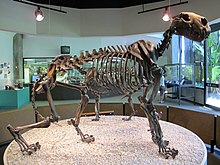美洲拟狮
| 美洲拟狮 化石时期:更新世
| |
|---|---|

| |
| 科学分类 | |
| 界: | 动物界 Animalia |
| 门: | 脊索动物门 Chordata |
| 纲: | 哺乳纲 Mammalia |
| 目: | 食肉目 Carnivora |
| 科: | 猫科 Felidae |
| 属: | 豹属 Panthera |
| 种: | †美洲拟狮 P. atrox
|
| 二名法 | |
| †Panthera atrox (Leidy, 1853)
| |

| |
| 穴狮分布区域(红色) 美洲拟狮分布区域(蓝色) 狮分布区域(绿色) | |
美洲拟狮(学名:Panthera atrox)又名拟狮或拟狮兽,是一种从化石得知已灭绝的猫科动物,生存于更新世时期的北美洲(340,000 - 11,000 年前)[1]。基因研究显示它是穴狮的姐妹群[2],为更新世巨型动物群,化石主要发现于美国洛杉矶的拉布雷亚沥青坑。美洲拟狮体型与更新世中期的原始狮大小相近,且比现今非洲的狮子大25%,为目前已知体型最大的猫科之一[3]。
分类学[编辑]

美洲拟狮最早由美国古生物学家约瑟夫·莱迪于 1853 年以 Felis atrox 为名命名并进行发表[4]。Hemmer 于 1974 年提议将美洲拟狮以三名法命名为 Panthera leo atrox[5],这项提议于 1985 年受到 Björn Kurten的支持[6]。
美洲拟狮一开始被认为是豹亚科下独立物种,学名为 Panthera atrox /ˈpænθərə ˈætrɒks/,拉丁文意思是“凶残的豹”。但是一部分的古生物学家认为美洲拟狮应为现存非洲狮及穴狮的近亲,而在之后将美洲拟狮命名为 P. leo atrox,列为非洲狮的亚种而非独立物种[7]。近年来,美洲拟狮与穴狮则再次被视为是独立物种[8]。
描述[编辑]


美洲拟狮的体长(不含尾巴)估计为 1.6至2.5米(5英尺3英寸至8英尺2英寸)[9],肩高则为 1.2米(3.9英尺),可比它的近亲原始狮,且大于斯剑虎(体重可达 280千克(620磅)),但仍小于同期体型最大的短面熊(当时北美洲体型最大的食肉目).[10]。一项 2008 年的研究认为美洲拟狮的体重可达 420千克(930磅)[11][12]。一项 2009 年针对最大体型样本的研究则认为雌狮的体重平均为 256千克(564磅),雄狮则为 351千克(774磅)[13]。一项 2008 年的研究预估雄狮的体重为 235—523千克(518—1,153英磅),雌狮为 175—365千克(386—805英磅),高于斯剑虎[14]。
在洛杉矶拉布雷亚沥青坑中已发现约有80个美洲拟狮标本,故此对它有较多资料[15]。美洲拟狮的特征及牙齿非常像现今的狮子,但体型较大。
发现于巴塔哥尼亚阿根廷地区洞穴里的美洲拟狮遗骸尚保有部分皮肤残骸,从这些皮肤样本上可以知道美洲拟狮具有偏红的体色,而阿根廷圣克鲁斯省圣庞沙的石洞壁画也证实了这点。体色的差异有助于科学家区别美洲拟狮与美洲豹的遗骸,因为在壁画中美洲豹被描述为具有偏黄的体色[16][17]。
分布[编辑]
美洲拟狮在更新世最先出现于阿拉斯加南部(桑加蒙间冰期,为最后一次的间冰期),并散布至亚伯达省与马里兰州,最南可至墨西哥恰帕斯州[18],北美洲中只有加拿大东部及美国东北部不见其踪影,可能因为当时当地环境为北方针叶林的关系[9][19][20]。原先美洲拟狮被认为在南北美洲生物大迁徙时扩展至南美洲东北部[21],然而秘鲁塔拉拉沥青坑发现的化石其实属于一种大型的美洲豹[22][23][24],另外在阿根廷及智利南部所发现的更新世南美洲豹化石,由于化石外型与美洲拟狮型态上近似,被怀疑更新世南美洲豹可能实际上为美洲拟狮的异名,但目前仍倾向认为更新世南美洲豹为现存美洲豹的亚种之一[17]。就像其他巨大的哺乳动物,它于约1万年前的更新世末灭绝。美洲拟狮的遗骸在育空及拉布雷亚沥青坑中非常普遍。
生活环境[编辑]
美洲拟狮和现代狮子一样生活在疏林草原和草原[3],一些美洲拟狮是生活在冰冷的气候环境。它们有可能生活于洞穴中或岩缝间,以躲避冰冷的天气[20]。它们可能以草或树叶铺巢,就像东北虎般[20]。
美洲拟狮在拉布雷亚沥青坑中的数量较斯剑虎或恐狼为少,相信它们比剑齿虎更有智慧避开陷阱[3],或不是猎食坑中猎物。美洲拟狮似乎是猎食鹿、史氏马、骆驼、加州貘、美洲野牛、猛犸象及其他巨型的草食性有蹄类[13][20]。
美洲拟狮的灭绝与全新世灭绝事件有关。它们的骨头可以在旧石器时代美洲原住民的垃圾中发现,所以被人类猎杀有可能是成因之一[9][20]。
美洲拟狮的第一个标本是一个颚骨,其复制品现正摆放在费城自然科学学院的约瑟夫·莱迪(Joseph Leidy)雕像之下。
分类[编辑]
美洲拟狮被认为是狮的亚种,但有的认为本身是一个种。在比较头颅骨后,有指穴狮较美洲拟狮更为接近老虎[25],但是基因研究结果指美洲拟狮与现今狮子有更接近的基因关系。[26]
参见[编辑]
名称[编辑]
因为目前业界对其是否能确定为狮类尚存在较大争议,故本文未从原文以美洲狮作译名,而是改译为美洲拟狮
参考文献[编辑]
- ^ Strauss, Bob. American Lion (Panthera leo atrox). About.Com Dinosaurs. The New York Times Company. [2012-03-10]. (原始内容存档于2016-09-27).
- ^ Barnett, R.; Shapiro, B.; Barnes, I. A. N.; Ho, S. Y. W.; Burger, J.; Yamaguchi, N.; Higham, T. F. G.; Wheeler, H. T.; Rosendahl, W.; Sher, A. V.; Sotnikova, M.; Kuznetsova, T.; Baryshnikov, G. F.; Martin, L. D.; Harington, C. R.; Burns, J. A.; Cooper, A. Phylogeography of lions (Panthera leo ssp.) reveals three distinct taxa and a late Pleistocene reduction in genetic diversity. Molecular Ecology. 2009, 18 (8): 1668–1677 [2019-02-05]. PMID 19302360. doi:10.1111/j.1365-294X.2009.04134.x. (原始内容存档于2018-09-20).
- ^ 3.0 3.1 3.2 Dr. Tom Deméré. SDNHM Fossil Mysteries Field Guide:American Lion. San Diego Natural History Museum. [2007-07-31]. (原始内容存档于2009-06-25).
- ^ Leidy, Joseph. Description of an Extinct Species of American Lion: Felis atrox. Transactions of the American Philosophical Society. 1853, 10: 319–322. JSTOR 1005282. doi:10.2307/1005282.
- ^ Hemmer, H. Untersuchungen zur Stammesgeschichte der Pantherkatzen (Pantherinae), Teil III: Zur Artgeschichte des Löwen Panthera (Panthera) leo (Linnaeus 1758). Veröffentlichungen der Zoologischen Staatssammlung München. 1974, 17: 167–280 [2019-12-12]. (原始内容存档于2019-05-17).
- ^ Kurtén, B. The Pleistocene lion of Beringia (PDF). Annales Zoologici Fennici. 1985, 22 (1): 117–121 [2019-12-12]. JSTOR 23734190. (原始内容存档 (PDF)于2020-07-26).
- ^ Christiansen, P.; Harris, J. M. Craniomandibular morphology and phylogenetic affinities of Panthera atrox: implications for the evolution and paleobiology of the lion lineage. Journal of Vertebrate Paleontology. 2009, 29 (3): 934−945. doi:10.1671/039.029.0314.
- ^ Barnett, R.; Mendoza, M. L. Z.; Soares, A. E. R.; Ho, S. Y. W.; Zazula, G.; Yamaguchi, N.; Shapiro, B.; Kirillova, I. V.; Larson, G.; Gilbert, M. T. P. Mitogenomics of the Extinct Cave Lion, Panthera spelaea (Goldfuss, 1810), Resolve its Position within the Panthera Cats. Open Quaternary. 2016, 2: 4 [2019-12-12]. doi:10.5334/oq.24. (原始内容存档于2018-07-21).
- ^ 9.0 9.1 9.2 Anderson, Elaine, Who's Who in the Pleistocene: A Mammalian Bestiary, Martin, P. S.; Klein, R. G. (编), Quaternary Extinctions, The University of Arizona Press, 1984 [2019-02-05], ISBN 978-0-8165-1100-6, (原始内容存档于2014-12-29)
- ^ Christiansen, P.; Harris, J. M. Body size of Smilodon (Mammalia: Felidae). Journal of Morphology. 2005-10-18, 266 (3): 369–384. PMID 16235255. doi:10.1002/jmor.10384.
- ^ Sorkin, B. A biomechanical constraint on body mass in terrestrial mammalian predators. Lethaia. 2008-04-10, 41 (4): 333–347. doi:10.1111/j.1502-3931.2007.00091.x.
- ^ Merriam, J. C. & Stock, C. 1932: The Felidae of Rancho La Brea. Carnegie Institution of Washington Publications 442, 1–231.
- ^ 13.0 13.1 Christiansen, Per; Harris, John M. Craniomandibular Morphology and Phylogenetic Affinities of Panthera atrox: Implications for the Evolution and Paleobiology of the Lion Lineage. Journal of Vertebrate Paleontology. 2009, 29 (3): 934–945. doi:10.1671/039.029.0314.
- ^ DeSantis, L. R.; Schubert, B. W.; Scott, J. R.; Ungar, P. S. Implications of diet for the extinction of saber-toothed cats and American lions. PLoS ONE. 2012, 7 (12): e52453. Bibcode:2012PLoSO...752453D. PMC 3530457
 . PMID 23300674. doi:10.1371/journal.pone.0052453.
. PMID 23300674. doi:10.1371/journal.pone.0052453.
- ^ About Rancho La Brea Mammals. Natural History Museum of Los Angeles County. 2012-08-06 [2017-10-28]. (原始内容存档于2017-10-28).
- ^ Revelan que el León Americano Habitó la Patagonia [They Reveal that the American Lion Inhabited Patagonia]. Todo Ciencia. [2020-09-16]. (原始内容存档于2001-10-20) (西班牙语).
- ^ 17.0 17.1 Chimento, N. R.; Agnolin, F. L. The fossil American lion (Panthera atrox) in South America: Palaeobiogeographical implications. Comptes Rendus Palevol. 2017, 16 (8): 850–864. doi:10.1016/j.crpv.2017.06.009.
- ^ Marisol Montellano, Ballesteros; Carbot-Chanona, Gerardo. Panthera leo atrox (Mammalia: Carnivora: Felidae) in Chiapas, Mexico. The Southwestern Naturalist. 2009, 54 (2): 217–222. doi:10.1894/clg-20.1.
- ^ Panthera leo atrox. Paleobiology Database. [2012-03-11]. (原始内容存档于2016-02-16).
- ^ 20.0 20.1 20.2 20.3 20.4 Harrington, C. R. American Lion (PDF). Yukon Beringia Interpretive Centre. March 1996 [2017-10-30]. (原始内容 (PDF)存档于2017-10-30).
- ^ Kurtén, B.; Anderson, E. Pleistocene Mammals of North America. Columbia University Press. 1980. ISBN 978-0231037334. OCLC 759120597.
- ^ Seymour, Kevin L. The Felinae (Mammalia: Felidae) from the Late Pleistocene tar seeps at Talara, Peru, with a critical examination of the fossil and recent felines of North and South America (MSc论文). University of Toronto. 1983.
- ^ Seymour, Kevin L. Perusing Talara: Overview of the Late Pleistocene fossils from the tar seeps of Peru (PDF). Science Series. 2015, 42: 97–109 [2019-02-05]. (原始内容 (PDF)存档于2018-10-01).
- ^ Yamaguchi, N.; Cooper, A.; Werdelin, L.; MacDonald, D. W. Evolution of the mane and group-living in the lion (Panthera leo): A review. Journal of Zoology. 2004, 263 (4): 329. doi:10.1017/S0952836904005242.
- ^ Groiss, J.Th. Der Hohlentiger Panthera tigris spelaea (Goldfuss). Neves Jahrb. Geol. Palaont. Abh. 1996, 7: 399–414.
- ^ Burger, Joachim; et al. Molecular phylogeny of the extinct cave lion Panthera leo spelaea (PDF). Mol. Phylogenet. Evol. 2004, 30: 841–849. (原始内容 (PDF)存档于2007-09-25).
外部链接[编辑]
- Prehistoric cats and prehistoric cat-like creatures (页面存档备份,存于互联网档案馆), from the Messybeast Cat Resource Archive.
- American lion, by C. R. Harrington, from Yukon Beringia Interpretative Center.
- Panthera atrox 1853, from the Academy of Natural Sciences. (the original specimen)
- Panthera Atrox in Cryptozoology (页面存档备份,存于互联网档案馆)
| ||||||||||||||||||||||||||||||||||||||||||||||||||||||||||||||||||||||||||||||||||||||||||||||||||||||||||||||||||||||||||||||||||||||||||||||||||||||||||||||||||||||||
| ||||||||||||





